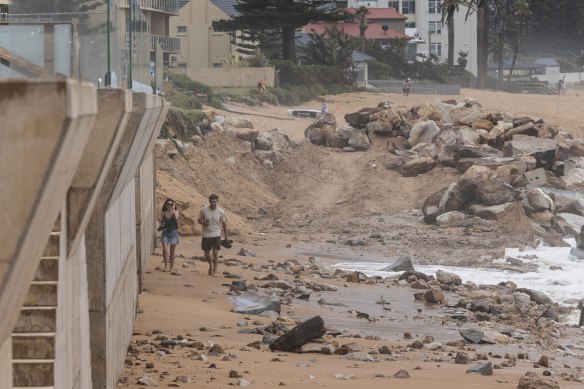- Exclusive
- Politics
- Federal
- Global warming
This was published 3 years ago
Disaster funding flows the wrong way in Australia: report
By Mike Foley
Almost all taxpayers’ money for natural disasters in Australia goes to the recovery phase, with only 3 per cent invested in preparation and mitigation, as a new report finds hundreds of billions of dollars would be saved with better planning.
Research from Deloitte Access Economics shows investment to prepare for natural disasters such as floods, fires, coastal damage, heatwaves and other catastrophes, combined with action to reduce greenhouse gas emissions, can save $380 billion in gross domestic product over the next 30 years.

Financial losses from coastal damage is forecast to rise under global warming. Credit: Brook Mitchell.
The research, commissioned by Andrew Forrest’s philanthropic Minderoo Foundation, estimated natural disasters had cost $120 billion over the past 50 years but, with escalating impacts from global warming, that bill is expected to hit $150 billion over the next decade, and keep rising to $1 trillion by 2050 under business as usual.
Last year the federal government announced an initiative to create an insurance pool for damage from cyclones and related flood damage, backed with $10 billion in public funds. It is an effort to reduce premiums for households in small businesses that now face greater risks due to climate change.
The Reserve Bank released an analysis in September that showed climate change could cut property prices across large sections of Sydney’s north, with many homeowners facing declining equity in their houses and rising insurance costs.
Deloitte Access Economics lead partner Pradeep Philip said the findings of his report were an “economic reality check” that should spur reforms to contribute to a reduction in global warming and help communities mitigate future disasters because both issues are “intrinsically linked”.
“For Australia, mitigation alone will not be enough,” Dr Philip said. “Adaptation requires adjusting to actual or expected future climate changes to reduce our vulnerability to asset and customer risks.”
Big-scale projects that will be required to mitigate future natural disasters must be tackled now because they take decades to complete, said general manager of natural disaster consultancy Risk Frontiers, Andrew Gissing.
Priority initiatives include retarding basins and levees to reduce flood damage, preparing housing stock for more intense cyclones in northern Australia, and enhanced building standards for bushfire mitigation, Mr Gissing said.
Increased damage from global warming was already “baked into the future”, he said. The level of greenhouse gases in the atmosphere is set to cause the intensity of natural disasters to escalate - even if emissions were halted today.
“Insurance losses from floods and tropical cyclones present the greatest risk of financial impacts to Australia,” Mr Gissing said.
The past seven years have been the world’s seven warmest on record and 2021 was the fifth hottest, according to data from leading climate change authority, the Copernicus Climate Change Service.
A La Nina weather pattern has also taken hold in the southern hemisphere over the past two years, delivering scorching temperatures to South America and flooding to Australia’s east coast.
The La Nina cycle typically brings cooler than average temperatures to the eastern seaboard. But the underlying influence of global warming means 2021 had rainfall that was simultaneously 9 per cent above average and also the 19th hottest since records began in 1910.
Meanwhile, towns in Western Australia’s Pilbara region last week notched some of the hottest temperatures ever recorded in Australia, with the mercury soaring to 50.7 degrees.
Dr Philip said heat stress was “one of the biggest drivers of economic damage for business because it effects labour productivity in Australia’s large service sector”.
Mr Forrest, founder and chairman of iron ore miner Fortescue Metals Group, is one of Australia’s biggest carbon emitters with more than 2 million tonnes of greenhouse gases per year. Dr Forrest is diversifying the business into renewable energy and zero-emissions hydrogen projects with ambitious goals for rapid emissions reductions.
A guide to the environment, what’s happening to it, what’s being done about it and what it means for the future. Sign up to our fortnightly Environment newsletter here.